人教版高中英语选修9 Unit 2 Sailing the oceans Reading 课件(17张PPT无相关视频)
文档属性
| 名称 | 人教版高中英语选修9 Unit 2 Sailing the oceans Reading 课件(17张PPT无相关视频) |
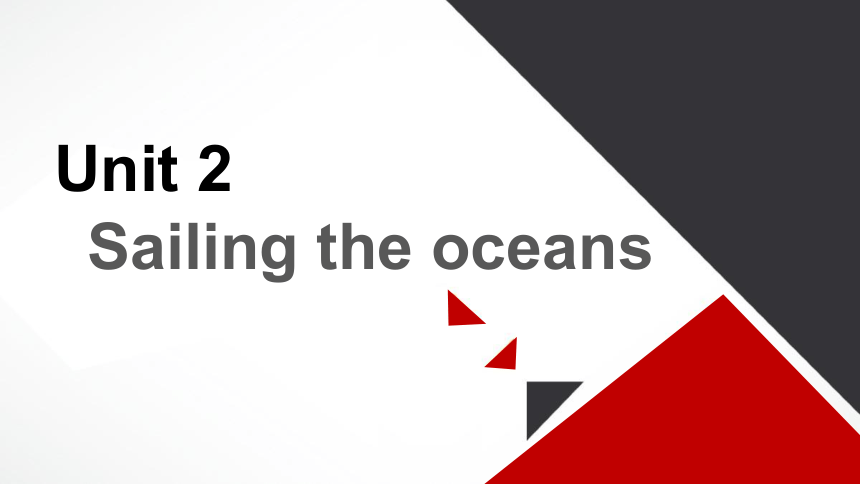
|
|
| 格式 | zip | ||
| 文件大小 | 1.4MB | ||
| 资源类型 | 教案 | ||
| 版本资源 | 人教版(新课程标准) | ||
| 科目 | 英语 | ||
| 更新时间 | 2020-07-04 17:55:16 | ||
图片预览


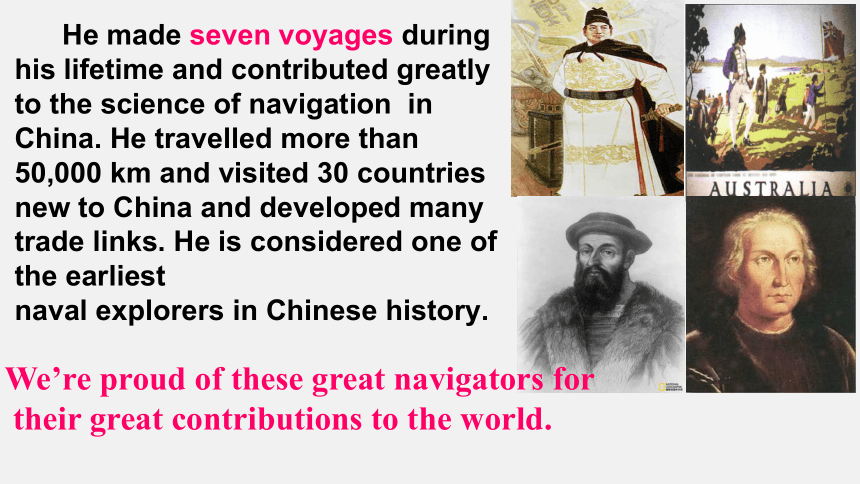

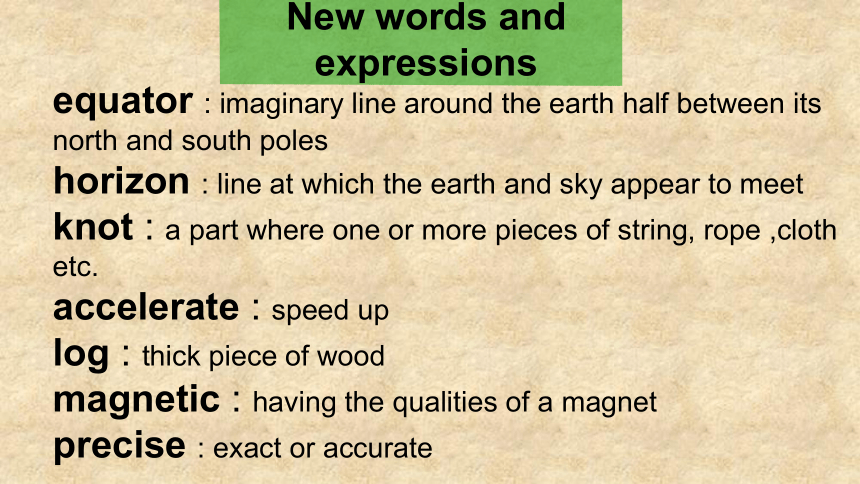
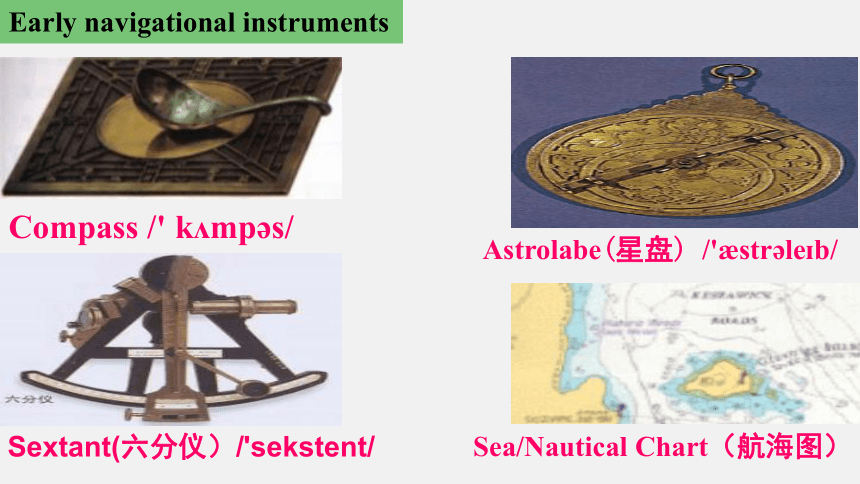
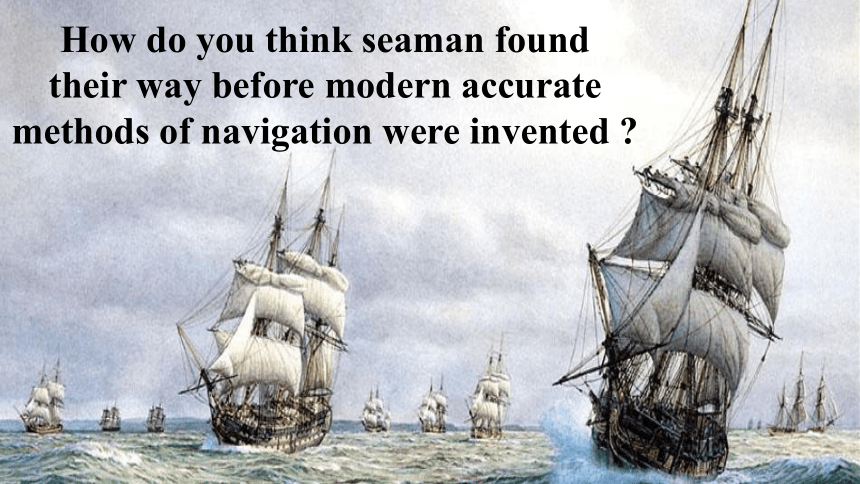
文档简介
(共17张PPT)
Unit
2
Sailing
the
oceans
See
a
film
and
answer
the
question:
What
is
about
the
film?
Lead-in:
He
made
seven
voyages
during
his
lifetime
and
contributed
greatly
to
the
science
of
navigation
in
China.
He
travelled
more
than
50,000
km
and
visited
30
countries
new
to
China
and
developed
many
trade
links.
He
is
considered
one
of
the
earliest
naval
explorers
in
Chinese
history.
We’re
proud
of
these
great
navigators
for
their
great
contributions
to
the
world.
New
words
and
expressions
voyage
:long
journey
by
sea
or
in
space
mercy
:
kindness
or
forgiveness
at
the
mercy
of
:
under
the
control
of
sb.
or
sth.
encyclopedia
:
book
or
set
of
books
giving
information
about
every
branch
of
knowledge
exploration
:
activity
of
exploring
minimum
:
least
or
smallest
celestial
:heavenly;
of
the
sky
pole
:
point
New
words
and
expressions
equator
:
imaginary
line
around
the
earth
half
between
its
north
and
south
poles
horizon
:
line
at
which
the
earth
and
sky
appear
to
meet
knot
:
a
part
where
one
or
more
pieces
of
string,
rope
,cloth
etc.
accelerate
:
speed
up
log
:
thick
piece
of
wood
magnetic
:
having
the
qualities
of
a
magnet
precise
:
exact
or
accurate
Compass
/'
k?mp?s/
Astrolabe(星盘)
/'?str?le?b/
Sextant(六分仪)/'sekstent/
Sea/Nautical
Chart(航海图)
Early
navigational
instruments
How
do
you
think
seaman
found
their
way
before
modern
accurate
methods
of
navigation
were
invented
?
1.What
is
the
type
of
writing
of
the
passage?
A.
Narration(记叙文)
B.
exposition
(说明文)
C.
argumentation
(议论文)
2.
How
many
instruments
are
used
to
find
latitude?
A.
3
B.
4
C.
2
D.
5
Fast-reading
B
B
1.How
did
they
use
nature
to
help
sail
the
oceans?
2.Why
did
they
use
instruments
in
the
sailing?
3.Why
are
speed
and
time
important
in
working
out
the
longitude
of
the
ship?
4.What
are
the
working
principles
of
the
following
instruments?
Bearing
circle
/
Sextant
5.
What
are
the
language
features(特点)of
the
passage?
6.
What
can
we
learn
from
ancient
navigators?
Detailed
reading
1.How
did
they
use
nature
to
help
sail
the
oceans?
Keeping
alongside
the
coastline
Using
celestial
bodies
Using
wildlife
Using
the
weather
Using
the
sea
Using
celestial
bodies
to
plot
the
positions
to
work
out
the
latitude
a
special
cloud
formation
indicates
there
is
land
close
by
Using
wildlife
If
seaweed
was
fresh
and
smelled
strongly,
the
ship
was
close
to
land.
Sea
birds
could
be
used
to
show
the
way
to
land
when
it
was
nowhere
to
be
seen.
Using
the
weather
To
help
identify
the
position
of
a
stream
or
river
when…
To
direct
their
sailing
fog
wind
2.Why
did
they
use
instruments
in
the
sailing?
Because
they
could
use
them
to
find
longitude
and
latitude.
3.Why
are
speed
and
time
important
in
working
out
the
longitude
of
the
ship?
Because
the
earth
moves
fifteen
degrees
westwards
every
hour.
If
you
know
your
direction,
speed
and
time,
you
can
work
out
the
approximate
longitude.
4.Try
using
your
own
words
to
describle
the
working
principles
of
the
following
instruments?
Bearing
circle
/Sextant
5.What
are
the
language
features
of
the
passage?
6.What
can
we
learn
from
ancient
navigators?
concise
precise
scientific
specific
brave
acute
determined
accurate
practical
patient
hard-working
creative
When
you
write
the
summary,
please
pay
attention
to
the
following
points:
1.How
to
start
a
summary
and
start
with
the
third
person
(tell/discuss/note/state/explain/emphasize/);
2.You
just
write
the
main
points
and
leave
out
the
detailed
information
with
no
comments.
3.Your
language
should
be
concise,
accurate
and
vivid
if
possible
;
4.Please
use
some
conjunctions
to
make
your
summary
more
natural;
5.Finish
the
summary
within
40words;
6.As
time
is
limited,
different
groups
write
different
parts.
Summary-writing
1.Read
the
passage
again
to
further
understand
the
passage.
2.Polish
your
micro-writing.
3.Each
group
choose
a
situation
of
Exercise
3
in
“comprehending
”
to
finish
it
,and
next
period
we’ll
check
and
share
your
answers.
Homework
Unit
2
Sailing
the
oceans
See
a
film
and
answer
the
question:
What
is
about
the
film?
Lead-in:
He
made
seven
voyages
during
his
lifetime
and
contributed
greatly
to
the
science
of
navigation
in
China.
He
travelled
more
than
50,000
km
and
visited
30
countries
new
to
China
and
developed
many
trade
links.
He
is
considered
one
of
the
earliest
naval
explorers
in
Chinese
history.
We’re
proud
of
these
great
navigators
for
their
great
contributions
to
the
world.
New
words
and
expressions
voyage
:long
journey
by
sea
or
in
space
mercy
:
kindness
or
forgiveness
at
the
mercy
of
:
under
the
control
of
sb.
or
sth.
encyclopedia
:
book
or
set
of
books
giving
information
about
every
branch
of
knowledge
exploration
:
activity
of
exploring
minimum
:
least
or
smallest
celestial
:heavenly;
of
the
sky
pole
:
point
New
words
and
expressions
equator
:
imaginary
line
around
the
earth
half
between
its
north
and
south
poles
horizon
:
line
at
which
the
earth
and
sky
appear
to
meet
knot
:
a
part
where
one
or
more
pieces
of
string,
rope
,cloth
etc.
accelerate
:
speed
up
log
:
thick
piece
of
wood
magnetic
:
having
the
qualities
of
a
magnet
precise
:
exact
or
accurate
Compass
/'
k?mp?s/
Astrolabe(星盘)
/'?str?le?b/
Sextant(六分仪)/'sekstent/
Sea/Nautical
Chart(航海图)
Early
navigational
instruments
How
do
you
think
seaman
found
their
way
before
modern
accurate
methods
of
navigation
were
invented
?
1.What
is
the
type
of
writing
of
the
passage?
A.
Narration(记叙文)
B.
exposition
(说明文)
C.
argumentation
(议论文)
2.
How
many
instruments
are
used
to
find
latitude?
A.
3
B.
4
C.
2
D.
5
Fast-reading
B
B
1.How
did
they
use
nature
to
help
sail
the
oceans?
2.Why
did
they
use
instruments
in
the
sailing?
3.Why
are
speed
and
time
important
in
working
out
the
longitude
of
the
ship?
4.What
are
the
working
principles
of
the
following
instruments?
Bearing
circle
/
Sextant
5.
What
are
the
language
features(特点)of
the
passage?
6.
What
can
we
learn
from
ancient
navigators?
Detailed
reading
1.How
did
they
use
nature
to
help
sail
the
oceans?
Keeping
alongside
the
coastline
Using
celestial
bodies
Using
wildlife
Using
the
weather
Using
the
sea
Using
celestial
bodies
to
plot
the
positions
to
work
out
the
latitude
a
special
cloud
formation
indicates
there
is
land
close
by
Using
wildlife
If
seaweed
was
fresh
and
smelled
strongly,
the
ship
was
close
to
land.
Sea
birds
could
be
used
to
show
the
way
to
land
when
it
was
nowhere
to
be
seen.
Using
the
weather
To
help
identify
the
position
of
a
stream
or
river
when…
To
direct
their
sailing
fog
wind
2.Why
did
they
use
instruments
in
the
sailing?
Because
they
could
use
them
to
find
longitude
and
latitude.
3.Why
are
speed
and
time
important
in
working
out
the
longitude
of
the
ship?
Because
the
earth
moves
fifteen
degrees
westwards
every
hour.
If
you
know
your
direction,
speed
and
time,
you
can
work
out
the
approximate
longitude.
4.Try
using
your
own
words
to
describle
the
working
principles
of
the
following
instruments?
Bearing
circle
/Sextant
5.What
are
the
language
features
of
the
passage?
6.What
can
we
learn
from
ancient
navigators?
concise
precise
scientific
specific
brave
acute
determined
accurate
practical
patient
hard-working
creative
When
you
write
the
summary,
please
pay
attention
to
the
following
points:
1.How
to
start
a
summary
and
start
with
the
third
person
(tell/discuss/note/state/explain/emphasize/);
2.You
just
write
the
main
points
and
leave
out
the
detailed
information
with
no
comments.
3.Your
language
should
be
concise,
accurate
and
vivid
if
possible
;
4.Please
use
some
conjunctions
to
make
your
summary
more
natural;
5.Finish
the
summary
within
40words;
6.As
time
is
limited,
different
groups
write
different
parts.
Summary-writing
1.Read
the
passage
again
to
further
understand
the
passage.
2.Polish
your
micro-writing.
3.Each
group
choose
a
situation
of
Exercise
3
in
“comprehending
”
to
finish
it
,and
next
period
we’ll
check
and
share
your
answers.
Homework
